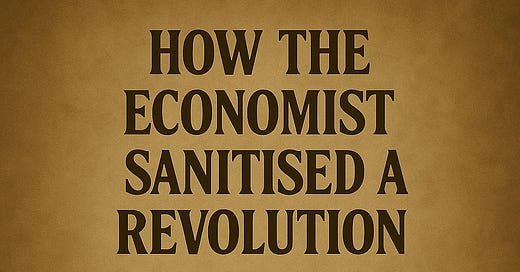How The Economist Sanitised a Revolution
ဖိုင် 008: Myanmar’s uprising isn’t failing. Global narratives are.
The Economist’s June 4th piece on Myanmar wears the mask of global analysis: clean, composed, quietly superior. But behind the map graphics and murmured concern lies something colder. Not just a misreading of crisis, but a system designed to erase agency while preserving power.
This is not a briefing on collapse. It is a blueprint for tolerating dictatorship. A user manual for narrative control. A performance of concern designed to end in polite resignation. It does not ask how military rule might be dismantled. It asks how long the world can live with it.
Fog as Frame
The collapse is not described as brutality, but as atmosphere. Myanmar is said to be “degenerating” into a violent state of nature, language that dissolves a military campaign into mist. There is no architect of violence, no structure, no intent, only a landscape of vague disorder. The junta’s current war crimes are not named. The perpetrators disappear into phrases like “lethal results” and “anarchy”. Airstrikes arrive without pilots. Displacement happens without cause. Villages vanish inside the sentence structure. The blood is wiped from the prose.
Resistance Rendered Invisible
The people fighting back are blurred into a “swirling cast” of armed groups, freedom fighters, and bandits. The National Unity Government (NUG) is never mentioned. The PDFs are unnamed. Civil servants who refused to serve a terror state do not exist. Jungle schools and resistance clinics are too inconvenient for the narrative. This is not oversight. It is strategy. If resistance cannot be erased on the ground, it will be erased through language. By removing names, the article removes responsibility. By removing structure, it removes credibility. What remains is noise, disorder without vision, conflict without politics.
China Is Strategic. The People Are Static.
China is granted detail, its pipelines, arms deals, diplomatic leverage, infrastructure routes. Its motives are parsed. Its strategies respected. The people of Myanmar are given none of this. Their struggle is unmapped. Their governance ignored. Their dignity excluded. There is no exploration of how local administration has emerged under fire. No attention to parallel structures of education, justice, and healthcare. No recognition that resistance is not only military, it is civic, collective, and deeply principled. Where China is portrayed as the adult in the room, the people are reduced to the mess on the floor.
The Trick: Shrink the Future
The article does not dismiss the revolution outright. It drains it of seriousness. Hope becomes naive. Vision becomes delusion. Belief in a democratic Myanmar becomes not wrong, but inconvenient. The ideal rebel is not the one who fights to win, but the one who delivers aid without asking questions. The only resistance worth acknowledging is the kind that can be stabilised and controlled. This is not a future built on justice. It is one shaped for convenience.
What the Article Refuses to See
This is not simply state failure. It is a people’s revolution. In less than four years, Myanmar’s military has lost control of vast regions now governed by resistance actors. Federalist visions are being tested. Civic structures have emerged. Education, justice, healthcare—rebuilt under fire. Ethnic alliances have deepened. The junta no longer rules most of the country. It bombs what it cannot control. The revolution has already reshaped Myanmar, not in theory, but in fact. What the article refuses to see is not complexity. It is transformation. And to acknowledge that transformation would require choosing sides.
What This Article Really Does
It prepares its audience for a world where the junta remains. It reduces democratic resistance to noise. It paints China as the only actor with strategy and reach. It rebrands a war of liberation as a theatre of chaos. And it does so with the quiet authority of someone who will never pay the cost of being wrong.
သတိထားပါ (Take heed):
This is not an article about Myanmar. It is an article about what the international order is willing to tolerate. It names violence without naming power. It describes suffering without naming the system that causes it. It observes collapse without asking who benefits from the ruins. It does not ask what liberation requires. It asks what level of oppression the world can digest. When resistance is blurred and dictatorship is made legible, it is not balance. It is betrayal. When stability is used to justify silence, it is not analysis. It is complicity. And when a revolution unfolds in plain sight, but your words pretend it never began, your neutrality is not neutral. It is strategy.
Article Referenced:
The Economist, “Myanmar is a demonstration of Chinese hegemony in action,” Leaders, June 4, 2025.



